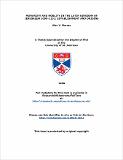Files in this item
Monarchy and nobility in the Latin Kingdom of Jerusalem, 1099-113: establishment and origins
Item metadata
| dc.contributor.advisor | Kennedy, Hugh (Hugh N.) | |
| dc.contributor.author | Murray, Alan V. | |
| dc.coverage.spatial | 244 | en_US |
| dc.date.accessioned | 2012-06-05T10:41:30Z | |
| dc.date.available | 2012-06-05T10:41:30Z | |
| dc.date.issued | 1988 | |
| dc.identifier.uri | https://hdl.handle.net/10023/2641 | |
| dc.description.abstract | The starting-point of this thesis is the question of the origin of the nobility in the Latin Kingdom of Jerusalem up to 1131. This is discussed in parallel with the question of the origins of the monarchy itself and that of relations between the two institutions. Chapter 1 discusses the European origins of the monarchy which derived from two distinct dynastic traditions, the House of Ardennes-Verdun whose power had declined in the later eleventh century and was extinguished on the eve of the crusade, and the House of Boulogne which was in an ascendant. Chapter 2 examines Godfrey of Bouillon's crusading army between 1096 and 1099. Originally almost exclusively Lotharingian in composition, the army absorbed numerous elements from other contingents in the course of the march. The minority who remained in Outremer after 1099 were of diverse origin and had developed strong ties to the Ardennes-Boulogne family. Chapter 3 re-assesses the generally accepted nature of the state established in Palestine by the First Crusade, arguing that this was a secular monarchy headed by a princeps whose authority derived from God. Chapter 4 deals with the origins of the nobility and is an analysis of prosopographical material presented in the Appendix, while Chapter 5 is a chronologically-based analysis of relations between monarchy and nobility. The nobility comprised four main groups: Lotharingians and Germans; Normans; Flemings, and Picards; and men from the Ile-de-France and the surrounding areas. The last group increased in numbers and influence after the accession of a new dynasty in the person of Baldwin II. Resentment against his policies, and a growing factionalism based on dynastic loyalties and geographical origins enabled sections of the nobilty to threaten the monarchy in this and the next reign. | en_US |
| dc.language.iso | en | en_US |
| dc.publisher | University of St Andrews | |
| dc.subject.lcc | D180.M7 | |
| dc.subject.lcsh | Nobility--Jerusalem--History--Latin Kingdom, 1099-1244 | en_US |
| dc.subject.lcsh | Kings and rulers--Jerusalem (Latin Kingdom)--Biography | en_US |
| dc.title | Monarchy and nobility in the Latin Kingdom of Jerusalem, 1099-113: establishment and origins | en_US |
| dc.type | Thesis | en_US |
| dc.type.qualificationlevel | Doctoral | en_US |
| dc.type.qualificationname | PhD Doctor of Philosophy | en_US |
| dc.publisher.institution | The University of St Andrews | en_US |
This item appears in the following Collection(s)
Items in the St Andrews Research Repository are protected by copyright, with all rights reserved, unless otherwise indicated.

